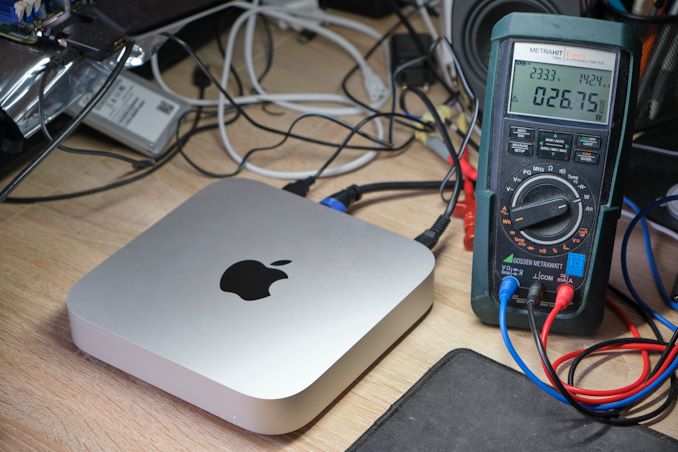The 2020 Mac Mini Unleashed: Putting Apple Silicon M1 To The Test
by Andrei Frumusanu on November 17, 2020 9:00 AM ESTConclusion & First Impressions
Today’s piece was less of a review on the new Mac mini as it was testing out Apple’s new M1 chip. We’ve had very little time with the device but hopefully were able to manage to showcase the key aspects of the new chip, and boy, it’s impressive.
For years now we’ve seen Apple’s custom CPU microarchitecture in A-series phone SoCs post impressive and repeated performance jumps generation after generation, and it today’s new Apple Silicon devices are essentially the culmination of the inevitable trajectory that Apple has been on.
In terms of power, the Apple M1 inside of the new Mac mini fills up a thermal budget up to around 20-24W from the SoC side. This is still clearly a low-power design, and Apple takes advantage of that to implement it into machines such as the now fan-less Macbook Air. We haven’t had opportunity to test that device yet, but we expect the same peak performance, although with more heavy throttling once the SoC saturates the heat dissipation of that design.
In the new Macbook Pro, we expect the M1 to showcase similar, if not identical performance to what we’ve seen on the new Mac mini. Frankly, I suspect Apple could have down-sized the Mini, although we don’t exactly now the internal layout of the piece as we weren’t allowed to disassemble it.
The performance of the new M1 in this “maximum performance” design with a small fan is outstandingly good. The M1 undisputedly outperforms the core performance of everything Intel has to offer, and battles it with AMD’s new Zen3, winning some, losing some. And in the mobile space in particular, there doesn’t seem to be an equivalent in either ST or MT performance – at least within the same power budgets.
What’s really important for the general public and Apple’s success is the fact that the performance of the M1 doesn’t feel any different than if you were using a very high-end Intel or AMD CPU. Apple achieving this in-house with their own design is a paradigm shift, and in the future will allow them to achieve a certain level of software-hardware vertical integration that just hasn’t been seen before and isn’t achieved yet by anybody else.
The software side of things already look good on day 1 due to Apple’s Rosetta2. Whilst the software doesn’t offer the best the hardware can offer, with time, as developers migrate their applications to native Apple Silicon support, the ecosystem will flourish. And in the meantime, the M1 is fast enough that it can absorb the performance hit from Rosetta2 and still deliver solid performance for all but the most CPU-critical x86 applications.
For developers, the Apple Silicon Macs also represent the very first full-fledged Arm machines on the market that have few-to-no compromises. This is a massive boost not just for Apple, but for the larger Arm ecosystem and the growing Arm cloud-computing business.
Overall, Apple hit it out of the park with the M1.











682 Comments
View All Comments
GeoffreyA - Thursday, December 3, 2020 - link
Sad, but true. I remember his "Road Ahead" article in 2014 and that was it. Gone. Well, let's hope the man leaves Apple someday and comes back home to Anandtech. I know, the chances of that happening are exceedingly slim.pjc15 - Saturday, November 21, 2020 - link
This might be evidence that ARM is the way of the future, but Intel, AMD, and Microsoft are too entrenched in x86 to do anything about it. They would have to maintain x86 and ARM versions of everything, and on the hardware side especially, they don't seem to have the bandwidth to do that. Maybe custom servers will move to ARM, maybe some types of pros will move to macOS if Apple's lead extends, but for the vast majority of cases, x86 is good enough and cheap enough that Wintel will be unaffected. In order to upend the industry, Apple would have to sell its chips to OEMs, or sell sub-$500 computers, both of which have almost no chance of happening.profquatermass - Sunday, November 22, 2020 - link
So where does the M1 go from here?How can they make the M2?
Spunjji - Monday, November 23, 2020 - link
The next move will probably be a larger variant with more (8?) large cores, more (+50%?) GPU resources, a wider (256bit?) memory bus, and LPDDR5. They're all fairly obvious ways to provide higher performance, but they mean a larger die, which means lower yields on a 5nm process that's still in its early stages.utferris - Wednesday, November 25, 2020 - link
I hope there will be Apple ISA. ARM ISA can be limiting at some point if apple want to have their own custom instructions for better performance.And NVidia will be owning ARM, which is the worst thing to Apple and the world.
Focher - Thursday, November 26, 2020 - link
Nvidia owning ARM will have zero impact on Apple.tokale - Friday, November 27, 2020 - link
This is the biggest misconception out there, some folks think Apple's chip fate it tied to ARM. Truth is the only thing ARM related to Apple's chips is the instruction set, everything else's is Apple's.PickUrPoison - Saturday, December 12, 2020 - link
True. But OP is right about instruction set extensions. Do we know there aren’t any? I expected some for perhaps the purpose of Rosetta2 performance acceleration, esp for the on the fly emulation vs. Rosetta2 translation.helpmeoutnow - Thursday, November 26, 2020 - link
looks like another bubble from Apple. but they will sell it as something amazing.PickUrPoison - Saturday, December 12, 2020 - link
Yes, congratulations to Apple, absolutely! As Andrei said, “overall, Apple hit it out of the park with the M1”.